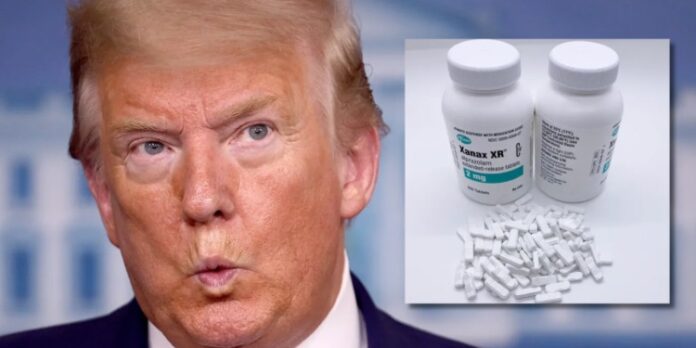Under Trump, the White House Medical Unit was “like the Wild West,” and staffers had easy access to powerful stimulants and sedatives
IF YOU EVER looked at the actions of the Trump White House and wondered, ‘Are they on drugs?’ — the answer was, in some cases, yes. Absolutely, yes.
In January, the Defense Department’s inspector general released a report detailing how the White House Medical Unit during the Trump administration distributed controlled substances with scant oversight and even sloppier record keeping. Investigators repeatedly noted that the unit had ordered thousands and thousands of doses of the stimulant modafinil, which has been used by military pilots for decades to stay alert during long missions.
The report didn’t say why so many of those pills had been given out. But for many who served in the Trump White House, the investigation highlighted an open secret. According to interviews with four former senior administration officials and others with knowledge of the matter, the stimulant was routinely given to staffers who needed an energy boost after a late night, or just a pick-me-up to handle another day at a uniquely stressful job. As one of the former officials tells Rolling Stone, the White House at that time was “awash in speed.”
Knowledgeable sources say that samples of the stimulant were passed around for those contributing lines to major Trump speeches, working late hours on foreign policy initiatives, responding to Special Counsel Robert Mueller’s probe, coping with the deluge of media inquiries about that investigation, and so much more. (Trump’s campaign did not respond to an email seeking comment for this story.)
Modafinil — also known by its brand name, Provigil — wasn’t the only controlled substance that Trump officials young and old routinely acquired. “It was kind of like the Wild West. Things were pretty loose. Whatever someone needs, we were going to fill this,” one source with direct knowledge of the matter recalls.
The anti-anxiety medication Xanax was also a popular, easy-to-get drug during the Trump years, three sources tell us. Neither Xanax nor its generic, alprazolam, is mentioned in the Pentagon report, which notes that it is not a comprehensive list of the controlled substances ordered during the Trump years. Two people with direct knowledge of the situation recall senior officials getting Xanax from the White House Medical Unit — and sharing it with colleagues.
The Trump administration was well known for its chaotic, often-erratic approach to policymaking — and for its atmosphere of paranoia, where staffers regularly spilled their colleagues’ secrets and bureaucratic factions often spent as much energy attacking one another as addressing matters of state. It’s impossible to know how much of that was fueled by the widespread availability of drugs like Xanax and Provigil. But what’s clear is that there was a breakdown of medical standards and safeguards at the highest levels of the American government; some staffers even believed that confidential information about their mental health was at risk. With Trump pushing to return to power on an agenda even more vicious than his first, a full accounting of the misuse of powerful stimulants and sedatives by his staff isn’t just a matter of historical interest. It’s a preview of a very possible future.
During Trump’s presidency, two sources say, senior staffers would repeatedly down Xanax with alcohol. Such a combination increases the risk of “serious, life-threatening side effects,” according to the National Library of Medicine. Nevertheless, senior officials would use Xanax and alcohol together to soothe themselves while enduring the sky-high levels of stress that come with working at the highest pressure environment job in America — with the added pleasure of serving the whims of the infamously volatile, intemperate Trump.
As one former senior administration official puts it: “You try working for him and not chasing pills with alcohol.”
THE WHITE HOUSE MEDICAL UNIT has been handing out prescription medications to staffers for decades — especially when they’re traveling abroad, and need to combat jet lag. “I think any White House staff knows that overseas trips are very grueling,” Stephanie Grisham, Trump’s former White House press secretary, recalls. “For us, you’d be on a flight with a president who never sleeps, and then you hit the ground running in a foreign country, and you have to be alert and ready for the president and other foreign leaders.”
She describes a procedure broadly familiar to staffers across administrations: On overseas trips, physician to the president Dr. Ronny Jackson “would come around Air Force One asking Donald Trump’s senior staff if they needed anything. This included Provigil and [the sleep aid] Ambien, and he would hand them out, typically in the form of packets with two or three pills in them. When this happened on Air Force One, a nurse would be trailing him, writing down who got what.”
It’s back home where things got sloppier, the Defense Department investigation and our sources note. Pills were often handed out without a specific need or diagnosis. Black-and-white procedures that doctors and pharmacists routinely follow when prescribing controlled substances were ignored. Orders for pills were often written down incorrectly, or not at all. One former White House Medical Unit staffer told Pentagon investigators that the unit “work[ed] in the gray… helping anybody who needs help to get this mission done.” Another said, “Is it being done appropriately or legally all the time? No. But are they going to get to that end result that the bosses want? Yeah.”
So while prescription drugs have long been in the White House — John F. Kennedy reportedly took a cocktail of uppers and downers to fight back pain, and Richard Nixon allegedly took an anti-epileptic drug “when his mood wasn’t too good” — they have rarely been dispensed as widely as they were in the Trump years.
The anything-anytime-anywhere approach inspired a sense of entitlement among Trump staffers. Some senior administration officials would casually mention their Xanax intake, one source with direct knowledge of the matter recalls. The source describes a time when an aide to Melania Trump walked into the White House Medical Unit and said, “‘Could you prescribe me Xanax.’ She just came in and demanded it.” The source wasn’t a doctor or pharmacist, however, and wasn’t allowed to prescribe the anti-anxiety drug. The source politely turned the aide down. “She stormed out,” the source says.
This is not, to put it mildly, how these drugs are ordinarily handled. “We tightly track controlled substances like this because they’re addictive or can cause overdoses,” says Dr. Beata Lewis, a psychiatrist based in Brooklyn. “It sounds like with all of these substances, people could get whatever they wanted. That puts people at risk for addiction.”
She adds: “The significant thing is these rules apply to everyone … except for the White House. It’s a culture of entitlement and being above the rules to the point of putting people in danger.”
There wasn’t much the medical unit staffers could do, even if they wanted to hold the line. Several told Pentagon investigators “they feared they would receive negative work assignments or be “fired” if they spoke out.
ADDING TO THE CLIMATE OF FEAR was the sense that even private therapy sessions would not be kept private in the Trump White House. The medical unit provided psychological counseling on request. But White House staffers were instructed to be on their guard. One former senior administration official tells Rolling Stone that within the first two years of the Trump presidency, they were warned by a colleague against divulging anything during a private White House medical session that they “would not want to be used against” them. At the time, this source notes, this puzzled the official, who was then told that under Trump, the office had a reputation for being more porous with private information “than you might expect.”
The former administration official didn’t think much of it at the time. The source shrugged the warning off as mere gossip and moved on. However, according to other individuals with intimate knowledge of the matter, it was hardly an idle rumor. Immediately after counseling sessions, therapists were pressed for information about what they were told.
“They’d say, ‘We need you to see this person.’ They’d walk me over there. I’d see this person. Then as soon as I got out, they would ask, ‘Hey what happened?’” one of these sources tells us. To this source, this was a blatant violation of patient confidentiality. The source would try to be as vague as possible in their responses to the questions, but in the Trump White House, “it was all kind of open kimono,” they say.
Keith Bass, who led the White House Medical Unit from 2017 to 2019, confirms that these sorts of debriefs did, in fact, happen after counseling sessions. But he says they never went into details; they were merely to determine whether a “medical/behavioral health event” would prevent a “military/DoD staff” member “from performing their duties or impac[t] their ability to maintain a [top secret] clearance while assigned to the White House,” Bass says in an email. “Detailed clinical notes were not required from the psychologist; only a broad overview to determine fitness for duty status.”
Our source says that’s not entirely accurate. For starters, these debriefs happened after therapy sessions with civilian staffers as well. And while the questions may have been “seemingly innocent,” the source says they could be seen as the start of a “slippery slope,” which would then “drif[t] down into asking for information that was not appropriate.”
The White House Medical Unit’s often casual approach to giving out controlled substances didn’t exactly inspire confidence. “The sloppiness around handing out medications had me highly concerned about the protection of behavioral health information — medical information at large. There was no protection of sensitive patient information, period,” the source says.
Any attempts to add more rigor were entirely unwelcome, the source adds. “The more I held to professional standards” — the more the source objected to the pressure to divulge details about therapy sessions, and to keep patient information private — the worse it got. White House staffers “ostracized me,” the source says. “Nobody would talk to me. The culture was toxic as fuck.”
MODAFINIL WAS DISCOVERED in the 1970s by French scientists and was first handed out to pilots to help keep them awake and on task in the 1991 Gulf War. The U.S. military started to use modafinil in earnest around the 2003 invasion of Iraq. At the time, it was heralded as a massive improvement over previous stimulants: stronger and more effective than caffeine, less physically addictive than amphetamines. “These medications aren’t stimulants like the old military ‘go pills,’ there are few if any side effects when taken as prescribed. They simply stave off drowsiness until the medication wears off, then you naturally fall asleep,” one knowledgeable source writes.
But that “taken as prescribed” caveat is crucial. When handed out willy-nilly, outside a doctor’s supervision, modafinil can pose serious risks, notes Dr. Rachel Teodorini, a researcher at London South Bank University’s division of psychology who has examined the drug and its effects. “If people have cardiovascular problems, heart problems, or blood pressure issues, it could cause things like strokes or heart attacks,” she tells us. And while modafinil doesn’t appear to physically hook patients, “there’s an element of at least psychological dependence. Tolerance builds up, and you need more and more.”
As a recent study in the journal Military Medicine notes, “although modafinil was initially said to comprise no risk for abuse, there are now indications that modafinil works on the same neurobiological mechanisms as other addictive stimulants.”
And just like with other stimulants, the overuse of modafinil can lead to the perceived need for anti-anxiety medications like Xanax. “Effectively, you’re using one drug to get you up and another to get you down,” Teodorini said.
Some former Trump staffers tell Rolling Stone they didn’t get these drugs directly from the White House Medical Unit. One former Trump White House aide concedes they “borrowed” some modafinil from “a friend,” who said they’d gotten it from the unit. “I had a lot going on in my life and I wanted some,” they say.
In other administrations, modafinil was used “99 percent of the time” for jet lag, one source notes. The Trump White House was a free-for-all. Two other sources each independently compared the White House during those years to college campuses where students cramming for finals or pulling all-nighters would pass around Adderall and other drugs, prescriptions be damned. But it wasn’t just the administration’s junior staffers — the recent college grads — who partook. The sources add that midlevel and certain senior officials — including those who reported to then-President Trump and First Lady Melania Trump — came to rely on modafinil, as well. The sources and former senior Trump officials, who all requested anonymity to discuss sensitive matters, recall instances of staff casually slipping the medical unit-provided stimulant to one another, in efforts to stay focused and help navigate the exhausting chaos of the Trump presidency.
It was “ironic” that Trump’s White House was “one place the war on drugs wasn’t being fought,” one of the former officials sardonically notes, given Trump and many of his lieutenants’ zeal for waging the international war on drugs.
NEARLY EVERY SOURCE INTERVIEWED for this story traced the problems with the White House Medical Unit back to Jackson, who joined the team during the George W. Bush administration and became physician to President Barack Obama in 2013. Before then, he was known as an eccentric. Afterward, he became a menace, as several Defense Department investigations detail.
On a trip to Argentina in March 2016, one of those reports notes, Jackson’s “intoxicated behavior in the middle of the night, pounding on [a female subordinate’s] hotel room door, screaming, yelling, and overall loud behavior in his hotel room exhibited less than exemplary workplace conduct while on official travel to provide medical care for the President.” The Pentagon interviewed 60 of Jackson’s former subordinates; 56 “experienced, saw, or heard about [him] yelling, screaming, cursing, or belittling subordinates.” During a six-week stretch in 2018, a Defense Department hotline received 12 complaints” about Jackson.
Jackson’s office did not respond to a request for comment. After this story was published, he complained on X that Rolling Stone is “nothing but a liberal rag,” and demanded the names of our sources.
His nomination to become Secretary of Veterans Affairs that same year was derailed over accusations he handed out pills to White House staffers like a “candyman.” (In one case, a Senate report noted, medical staffers fell “into a panic” because he had given such “a large supply” of Percocet pain pills to a member of the White House Military Office.)
Jackson briefly returned to the White House as Trump’s “chief medical adviser” in 2019 before running for Congress. But no matter what position he held, several sources tell us, his influence dominated medical care at the Trump White House, and Jackson’s “minions” and “loyalists” ran the White House Medical Unit in his stead. “Any practices existing at that time were all set up by Jackson, who’d been there for a dozen years. Though the med unit was led by an administrator, little happened without his say-so,” one of those sources say.
The source adds, “Unit leadership did slowly start making appropriate changes, but due to [the] complicated nature of missions, individual expectations within the organization, a self-imposed cone of silence and fear of being held liable for sins of the father, it took a long time to find the right way forward.”
OUR INTEREST IN THIS STORY was sparked, in part, by a handwritten ledger reprinted on page 14 of the January inspector general’s report: a tracking form for the controlled substances ordered by the White House Medical Unit. In addition to the thousands of pills of Ambien and Provigil listed are even more potent sedatives and pain pills: morphine, hydrocodone, diazepam and lorazepam (better known by their brand names, Valium and Ativan), fentanyl, and even ketamine.
Jackson, now a Republican congressman from Texas, told the Washington Post that his team prescribed narcotics “less than five times” across his tenure. And according to the paper’s sources, drugs like fentanyl were “kept on hand for extreme emergencies — such as a White House fence jumper impaling themselves on a spike.”
That’s a ridiculous example, a well-placed source tells us. “Someone just made up something. If there was a jumper, someone would call 911,” the source says. The jumper would then be transferred to a nearby civilian hospital.
But there was a grain of truth to the idea that the medical unit retained fentanyl and the like for extreme events. In the wake of the wars in Iraq and Afghanistan, there was a desire to bring the advances in battlefield medicine to the White House. If the president or vice president were to get shot in a remote location, far from any hospital, the unit’s physicians wanted to be able to insert a breathing tube into the VIP almost instantaneously, a process known as “rapid sequence induction and intubation.” Doing that requires sedating the patient in a hurry with powerful drugs.
“The unit employed the world’s standards in pre-hospital trauma care, as directed by the DoD’s Joint Trauma System & Committee on tactical-combat casualty-care guidelines. That includes the use of ketamine, fentanyl, etc. for pain management,” a second knowledgeable source writes. “The whole mission is contingency planning for providing most/best possible care for the worst/craziest scenarios.”
Needless to say, they never encountered a scenario that nuts. And we didn’t uncover any evidence that ketamine or fentanyl were handed out to White House staff the way Xanax and Provigil were.
But as the handwritten ledger shows — and our sources confirm — the medical unit’s procedures had grown so sloppy, so lax, that it’s impossible to prove the negative, that these sedatives and dissociatives weren’t given to White House staff. “In our analysis of the White House Medical Unit’s controlled substance records, we found that medications, such as opioids and sleep medications, were not properly accounted for,” the inspector general’s report reads. “These records frequently contained errors in the medication counts, illegible text, or crossed-out text that was not appropriately annotated.”
That might sound like minor errors in paperwork. They’re not. They’re the kind of transgressions that turn patients into addicts, and doctors into ex-doctors. “If you’re sloppy even a little bit with controlled substances, you’ll lose your [medical] license,” one source notes. Without proper record keeping, there’s no way to say just how much of the Trump White House was on drugs. There’s no way to tell how they might use — and abuse — prescription medications if they come back to power. “Nothing is written down,” another source says of the unit’s drug distribution during the Trump years, “because we will always get to yes.”












